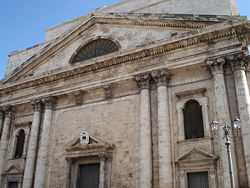Terlizzi
| Terlizzi | ||
|---|---|---|
| Comune | ||
| Comune di Terlizzi | ||
|
Terlizzi's most important church, the Concattedrale di San Michele Arcangelo. | ||
| ||
 Terlizzi Location of Terlizzi in Italy | ||
| Coordinates: 41°08′N 16°33′E / 41.133°N 16.550°E | ||
| Country | Italy | |
| Region |
| |
| Province | Bari | |
| Frazioni | Sovereto | |
| Government | ||
| • Mayor | Ninni Gemmato (PdL) | |
| Area | ||
| • Total | 68.30 km2 (26.37 sq mi) | |
| Elevation | 191 m (627 ft) | |
| Population (31 March 2008) | ||
| • Total | 27,404 | |
| • Density | 400/km2 (1,000/sq mi) | |
| Demonym | Terlizzesi | |
| Time zone | CET (UTC+1) | |
| • Summer (DST) | CEST (UTC+2) | |
| Postal code | 70038 | |
| Dialing code | 080 | |
| Patron saint | Madonna di Sovereto | |
| Saint day | April 23 | |
| Website | Official website | |
Terlizzi is a town and comune of the region of Apulia in southern Italy, in the province of Bari, lying to the west of the seaport of Bari on the Adriatic Sea, in the midst of a fertile plain. As of 2008, its population was some 27,400.
History
Terlizzi is first mentioned in an 8th-century AD document, when its Lombard possessor donated the area to the Abbey of Montecassino. After the Byzantine domination, from the 11th century Trelizzi was under the influence of the counts of Giovinazzo, whose member Amico fortified both the cities. Later it was ruled by the Tuzziaco, Wrunfort, Orsini di Taranto and Grimaldi families. The oldest map of Terlizzi still hangs in the Palace at Monte Carlo of the latter's house.
It became a commune after the Unification of Italy in 1861, when it had 18,000 inhabitants.
Main sights
It had a castle which at one time was very strong, and occasionally resorted to by the Emperor Frederick II, and later by the Aragonese sovereigns of Naples. Its remains include a 31-metre (102 ft) high clock tower in the center of town that was built by the Norman conquerors in the 12th century AD. The back-lit clock on that tower is the second largest in Europe after Big Ben.
The Co-Cathedral of San Michle Arcangelo was built in Neo-Classicist style in the 18th and 19th centuries, replacing the old Romanesque Duomo of the 13th century. It houses several canvasses and a notable collection of wooden statues.
The walls and towers of the town remain, but the fosse has been turned into boulevards.
Terlizzi has some trade in the wine and fruit of the region. In 1745, a fine Greek-made inkstand inlaid in silver was found in a nearby, ancient cove, in Suberito (at now, Sovereto). Starting from that date, was built a 22-metre (72 ft) tall triumphal wagon to keep the picture in Terlizzi's streets.
One of the last remaining stretches of the Appian Way that is still unpaved runs through the outskirts of Terlizzi. This stretch of the Appian Way is part of the Via Appia Traiana, built by Emperor Trajan sometime around 115 AD. Just off this road, 1 kilometre (0.6 miles) out of the town, is the church of Santa Maria di Cesano, built in 1055 AD. It houses a precious Byzantine fresco of Christ Pantocrator. In the centre of the city is notable the big Palace built by the Barons de Gemmis, with the annexed church of Santa Maria La Nova. It is from the 18th century and was designed by the architect Luigi Vanvitelli.
Notable people born in Terlizzi
- Ferrante de Gemmis- writer
- Gennaro de Gemmis - writer from the same family
- Nichi Vendola_ Governor of Apulia from 2005
- Michele de Napoli painter
- Giuseppe Millico (1739–1802)- castrato contemporary of Farinelli
References
| Wikimedia Commons has media related to Terlizzi. |

